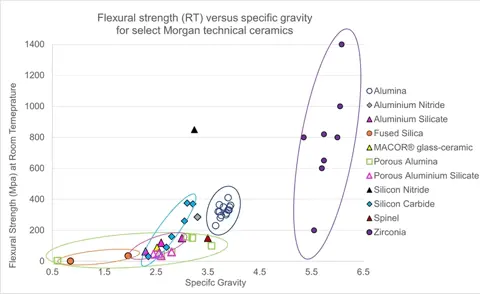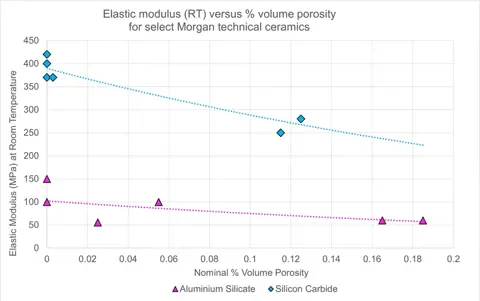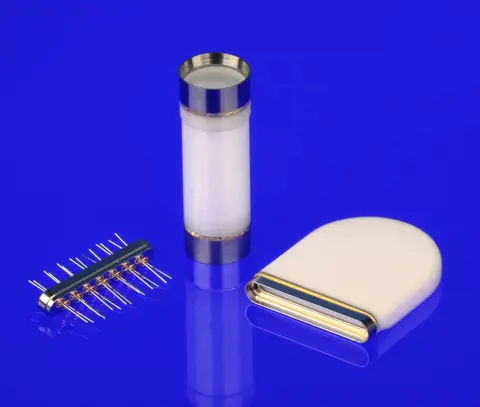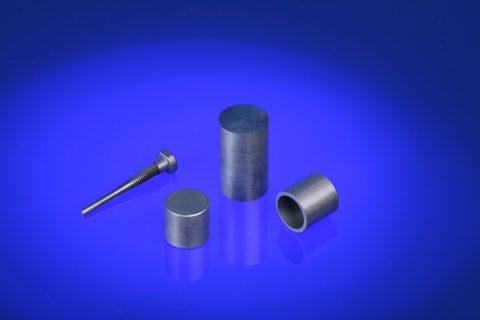Technical Ceramics

Microstructure
Contact usDensity
Density(ρ) is the mass of an object divided by the volume of the object and the units are commonly expressed as grams per cubic centimetre, or g/cm3. The densities of ceramics are typically 30% to 80% of the values of high-strength metal alloys such as steel, offering significant reduction in weight when replacing metals. This weight reduction can benefit the soldier wearing ceramic versus metallic armour and can improve the performance and energy efficiency of rotating equipment and vehicles.
Specific Gravity
Specific gravity, the density of a material divided by the density of water (1 gm/cm3) and is unitless.
Theoretical Density
Theoretical density is defined as the maximum density that a material can achieve assuming it is “perfect”, i.e. free of voids and contaminants.
Theoretical density for a molecule is calculated by the formula:
ρ = (Z x Mw) / (V x N), where:
Z = the number of molecules per unit cell
Mw = the molecular weight of the molecule (grams/mole)
V = the unit cell volume of the molecule (cm^3/cell)
N = Avogadro’s number (6.023 x 10^23)
Relative Density
Relative density, in the manner used in the ceramic’s industry, is a ceramics’ actual measured density divided by the calculated theoretical density of the ceramic, and it is stated as a percentage. This value provides an indication of the percent volume of voids and/or contaminants within the ceramic.
Generally, to maximise a ceramic’s mechanical properties, is it desired to obtain a high relative density (e.g. low porosity) as the charts illustrate.

Porosity
If it desired to maximise a ceramic’s thermal shock or insulative property, controlled and uniform pore size and pore volume is often introduced into the ceramic, lowering a ceramic’s relative density value. Porous fused silica is an example of a ceramic with optimised porosity to maximise thermal shock resistance. Magnesia, or Magnesium Oxide or MgO, is an example of a ceramic with optimised porosity to maximise electrical insulative properties.

Gas Permeability
Generally, ceramics made to maximise relative density contain internal porosity which is “closed” meaning the pores are isolated and are not interconnected to each other. A ceramic that contains only closed porosity is considered impermeable to gasses. Such an attribute is important if the ceramic is acting as a seal to prevent either gas or liquid leakage to and/or from a sealed container. Hermetic feedthroughs used for sealing electronic medical implants (e.g. pacemakers, cochlear devices, etc.) is an example where the ceramic seal is tested using helium gas to assure the seal is leak proof.
“Open” porosity refers to pores that are connected that can provide a pathway for gas or liquid to pass through the ceramic. Open porosity is useful for ceramic components that are used as filters, such as ceramic tubes used in physical vapour deposition processes.

Crystal Grain Size and Grain Boundaries
In addition to apparent density and porosity impacting a ceramic’s physical properties, the ceramic’s crystal grain size microstructure can influence certain properties such as tensile strength, fracture toughness, and hardness. Generally, ceramics that consist of very fine crystal gain sizes have higher strength values and hardness than those with larger grain sizes. This is because a structure that has smaller grains will contain a higher number of grains which means more boundaries between the individual grains. These grain boundaries hinder dislocation movement and fracture propagation.
Ceramics with relatively fine or small grain sizes are often referred to as Fine Ceramics, a term used interchangeable with Technical or Advanced Ceramics, implying ceramics with high mechanical properties.
Hardness
Ceramics are famous for their extreme hardness, inferior only to the hardness of diamond. This high hardness attribute is the reason certain ceramics are specified instead of metals in applications where low mechanical wear and/or low abrasive wear is critical. Examples applications include bearings, seal faces, cutters, grinders, valves, pumps and hydrocyclones.
Hardness is essentially a measure of deformation resistance. The hardness value of a ceramic can be obtained using the Vickers hardness (HV) test method and the value expressed in Pascals (Pa). The method uses a standard diamond pyramid shaped indenter under a prescribed compressive force (kg). The lengths of the two diagonals of the resulting diamond shaped indentation in the ceramic are optically measured and averaged, and then the HV value is calculated. Under a given load (kg), a harder material will have a shallower indentation versus a softer material and will result in a higher HV value. When reporting HV values it is important to indicate the value of the load that was used in the test as the results are dependent upon the load. For example, if a 10 kg load is used, the HV values will be expressed as HV10.
Carbides, such as silicon carbide, are typically the hardest ceramics.
Porosity and microstructure (e.g. crystal grain size) of the ceramic will affect the ceramic’s hardness value.




